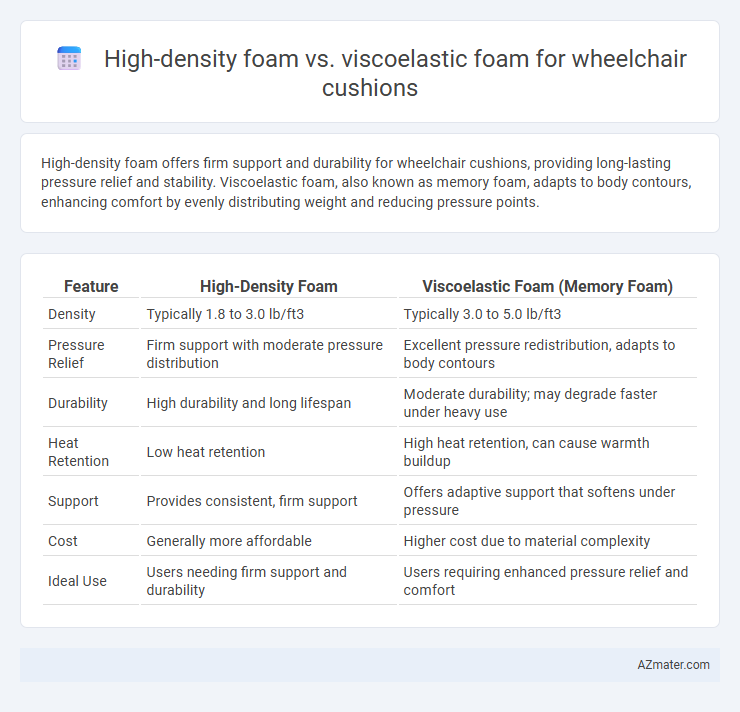High-density foam offers firm support and durability for wheelchair cushions, providing long-lasting pressure relief and stability. Viscoelastic foam, also known as memory foam, adapts to body contours, enhancing comfort by evenly distributing weight and reducing pressure points.
Table of Comparison
| Feature | High-Density Foam | Viscoelastic Foam (Memory Foam) |
|---|---|---|
| Density | Typically 1.8 to 3.0 lb/ft3 | Typically 3.0 to 5.0 lb/ft3 |
| Pressure Relief | Firm support with moderate pressure distribution | Excellent pressure redistribution, adapts to body contours |
| Durability | High durability and long lifespan | Moderate durability; may degrade faster under heavy use |
| Heat Retention | Low heat retention | High heat retention, can cause warmth buildup |
| Support | Provides consistent, firm support | Offers adaptive support that softens under pressure |
| Cost | Generally more affordable | Higher cost due to material complexity |
| Ideal Use | Users needing firm support and durability | Users requiring enhanced pressure relief and comfort |
Introduction to Wheelchair Cushion Materials
High-density foam offers firm support and durability, making it ideal for wheelchair cushions that require long-lasting pressure relief and stability. Viscoelastic foam, also known as memory foam, provides superior contouring and pressure distribution by molding to the user's body shape, reducing the risk of pressure ulcers. Choosing between these materials depends on individual needs for comfort, support, and skin protection in wheelchair seating solutions.
What is High-Density Foam?
High-density foam is a durable polyurethane material characterized by its firm support and ability to maintain shape under prolonged pressure, making it ideal for wheelchair cushions. Its dense cellular structure provides excellent weight distribution and reduces risk of pressure sores by minimizing shear forces. Compared to viscoelastic foam, high-density foam offers greater resilience and quicker recovery, ensuring long-lasting comfort and stability for wheelchair users.
Understanding Viscoelastic (Memory) Foam
Viscoelastic foam, commonly known as memory foam, adapts to the user's body shape by responding to heat and pressure, providing superior pressure relief and comfort for wheelchair cushions. This foam type reduces shear forces and evenly distributes weight, minimizing the risk of pressure ulcers in individuals with limited mobility. Compared to high-density foam, viscoelastic foam offers enhanced cushioning and personalized support, making it ideal for prolonged sitting and pressure management.
Pressure Redistribution: High-Density vs Viscoelastic Foam
High-density foam offers firm support with excellent load distribution, effectively reducing peak pressure points for wheelchair users. Viscoelastic foam, or memory foam, excels in pressure redistribution by conforming closely to body contours, enhancing comfort and minimizing tissue stress. Selecting the appropriate foam depends on individual pressure relief needs, with viscoelastic foam providing superior cushioning for prolonged sitting and high-density foam ensuring stable, durable support.
Comfort and Support Comparison
High-density foam offers firm support and durability, maintaining shape under prolonged pressure, making it suitable for users needing consistent posture stability. Viscoelastic foam, known for its pressure-relieving properties, contours to body shape and enhances comfort by reducing pressure points and improving weight distribution. Comparing both, viscoelastic foam excels in personalized comfort, while high-density foam provides superior structural support for long-term use in wheelchair cushions.
Durability and Longevity
High-density foam offers robust durability and maintains its shape under continuous pressure, making it a reliable choice for wheelchair cushions requiring long-term support. Viscoelastic foam, known for its pressure-relieving properties, tends to compress over time, which may reduce its lifespan compared to high-density foam. Selecting high-density foam ensures greater longevity and consistent performance in wheelchair cushions subject to daily use.
Temperature Regulation Features
High-density foam wheelchair cushions provide robust support but tend to retain heat due to their dense cell structure, which limits airflow and can cause discomfort during extended use. Viscoelastic foam, often known as memory foam, adapts to body contours but is prone to trapping heat because its viscoelastic properties reduce ventilation, potentially increasing skin temperature. Advanced wheelchair cushions incorporate gels or phase-change materials within viscoelastic foam to enhance temperature regulation by dissipating heat and improving breathability.
Maintenance and Cleaning Considerations
High-density foam wheelchair cushions offer easy maintenance due to their resilient structure, allowing simple surface cleaning with mild soap and water and quick drying, which prevents moisture buildup. Viscoelastic foam cushions require careful cleaning to avoid damage from excessive moisture, often needing specialized covers to protect the foam from sweat and spills. Both types benefit from removable, machine-washable covers, but viscoelastic foam demands more frequent cover laundering to maintain hygiene and prolong the foam's lifespan.
Cost Analysis: Which Foam Offers Better Value?
High-density foam wheelchair cushions typically offer a lower upfront cost compared to viscoelastic foam cushions, making them more accessible for budget-conscious users. Viscoelastic foam cushions, while more expensive initially, provide superior pressure relief and durability, potentially reducing long-term expenses related to cushion replacement and pressure ulcer treatment. Evaluating overall value, viscoelastic foam often delivers better cost-effectiveness through enhanced comfort and prolonged lifespan despite the higher initial investment.
Choosing the Right Foam for Individual Needs
High-density foam offers firm support and durability ideal for individuals requiring stable posture and pressure distribution in wheelchair cushions. Viscoelastic foam, also known as memory foam, provides superior contouring and pressure relief, making it suitable for users with sensitive skin or high risk of pressure ulcers. Selecting the right foam depends on factors like weight, mobility level, skin condition, and duration of wheelchair use to ensure optimal comfort and injury prevention.

Infographic: High-density foam vs Viscoelastic foam for Wheelchair cushion
 azmater.com
azmater.com